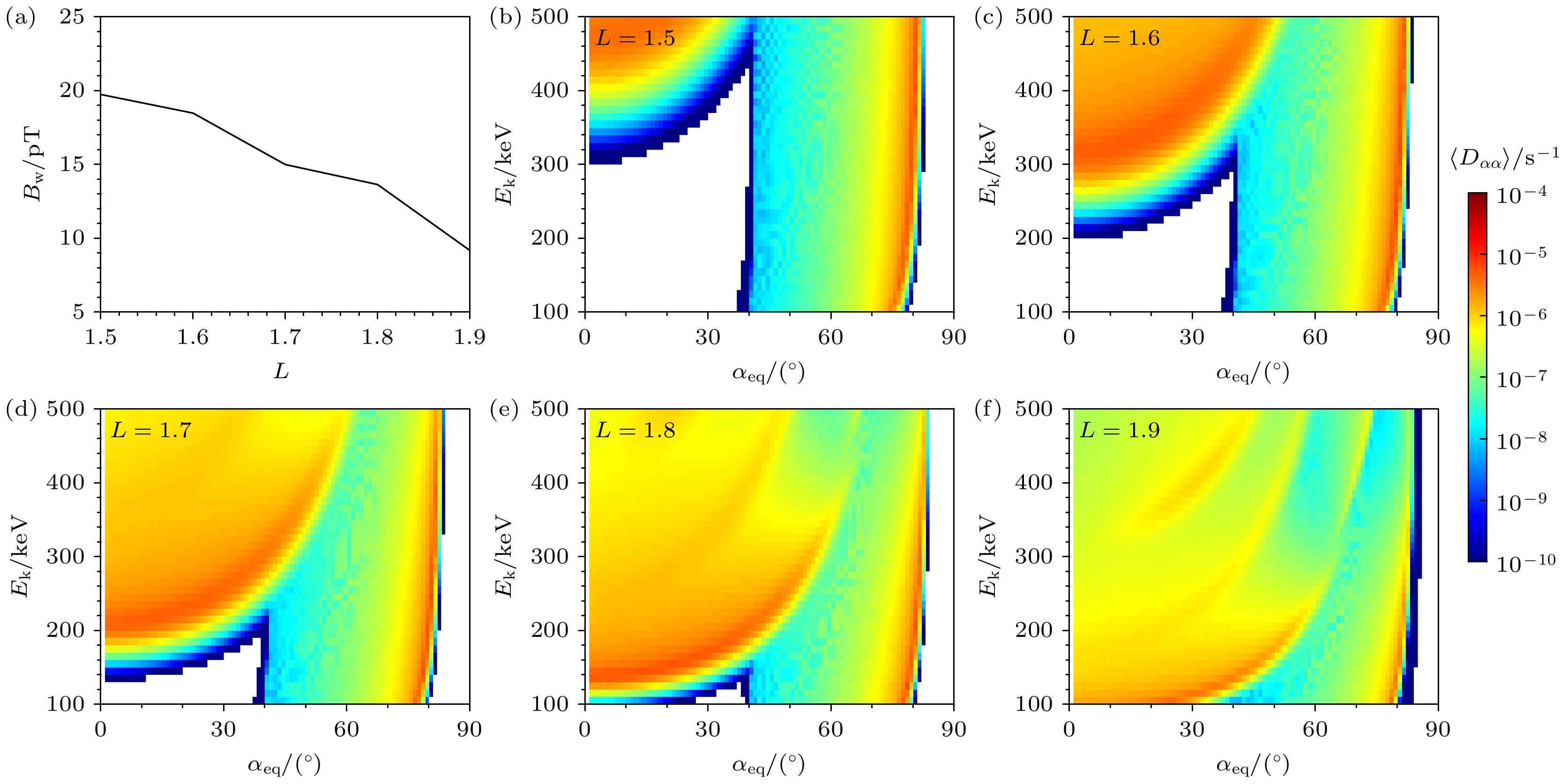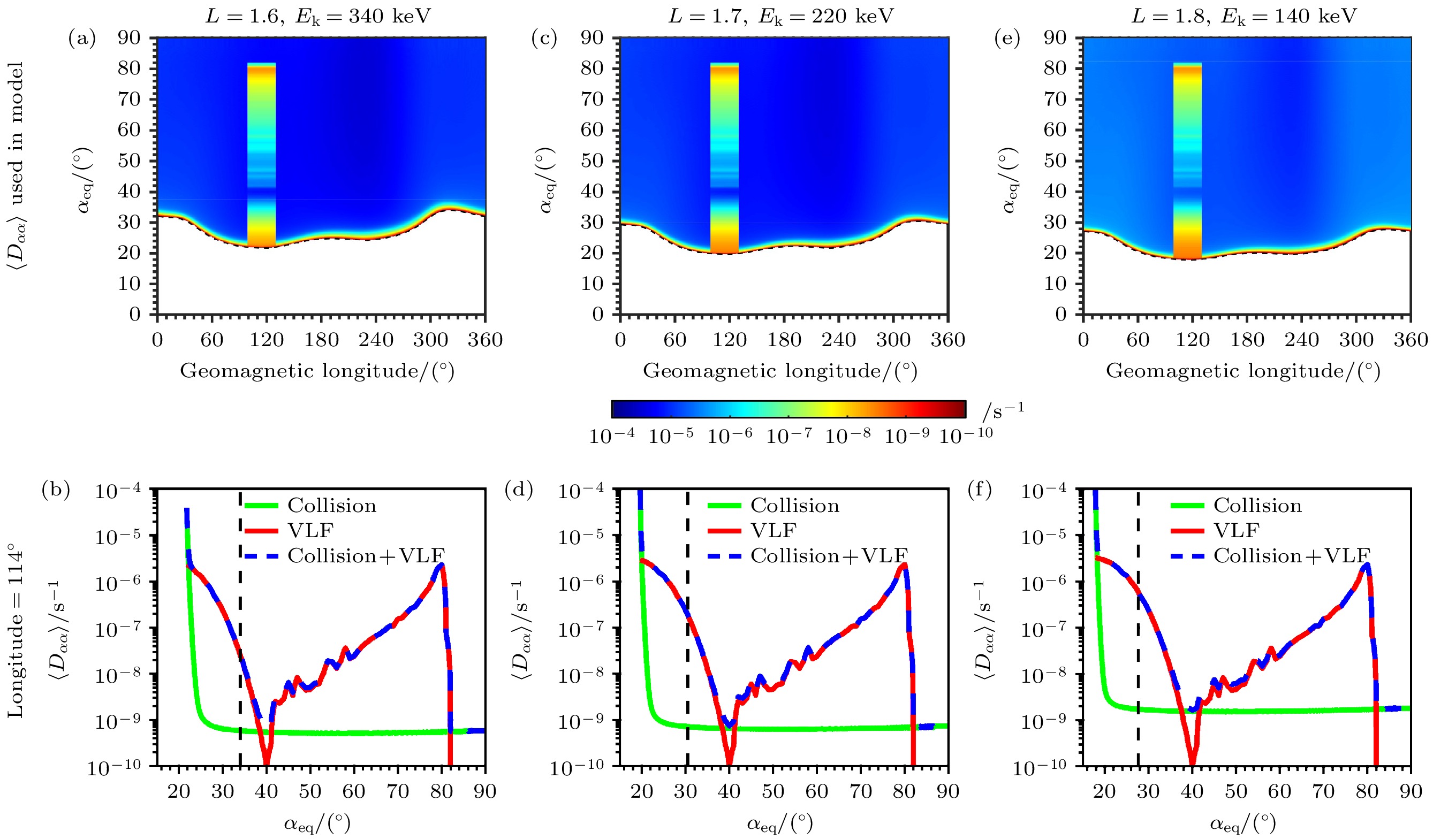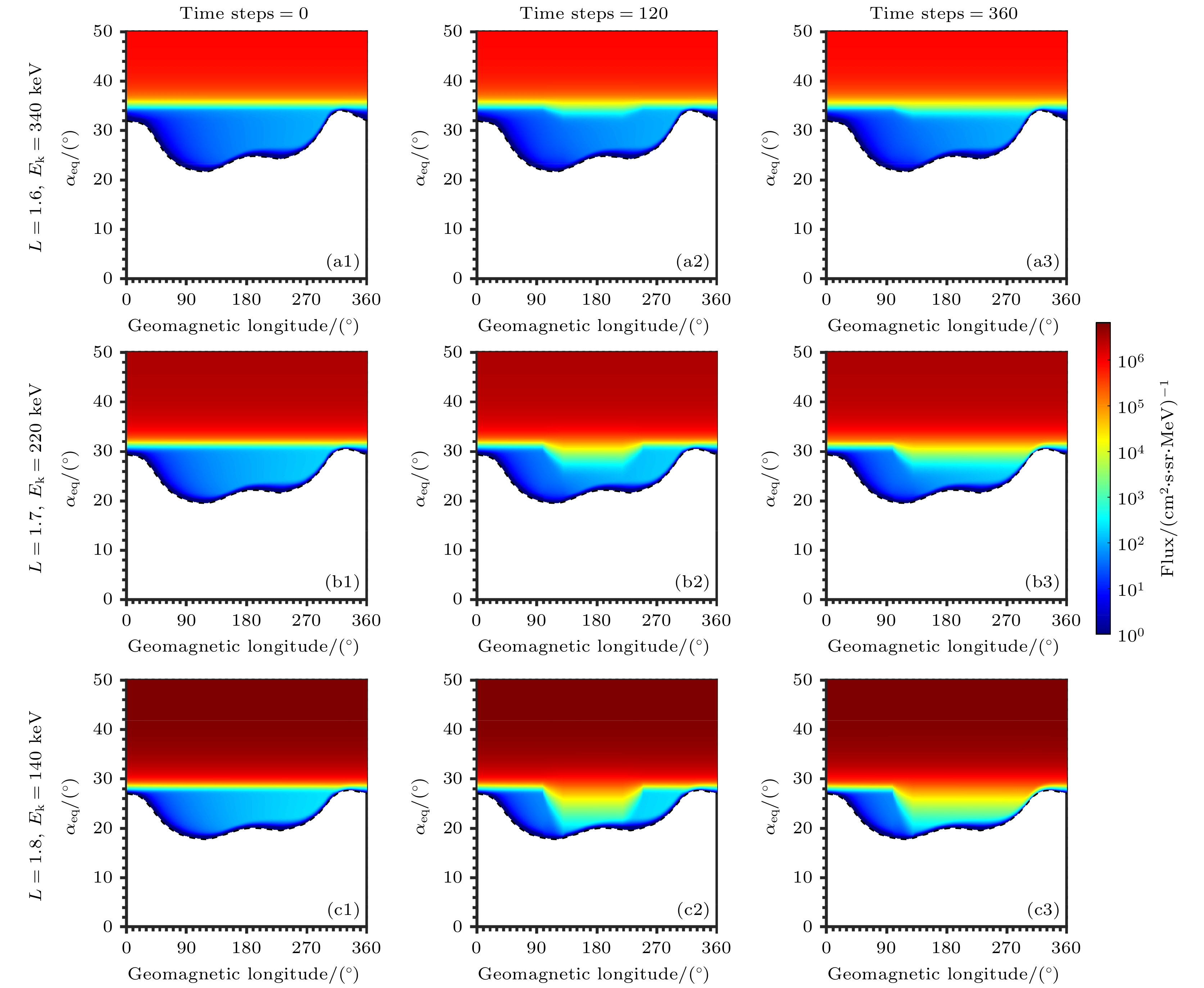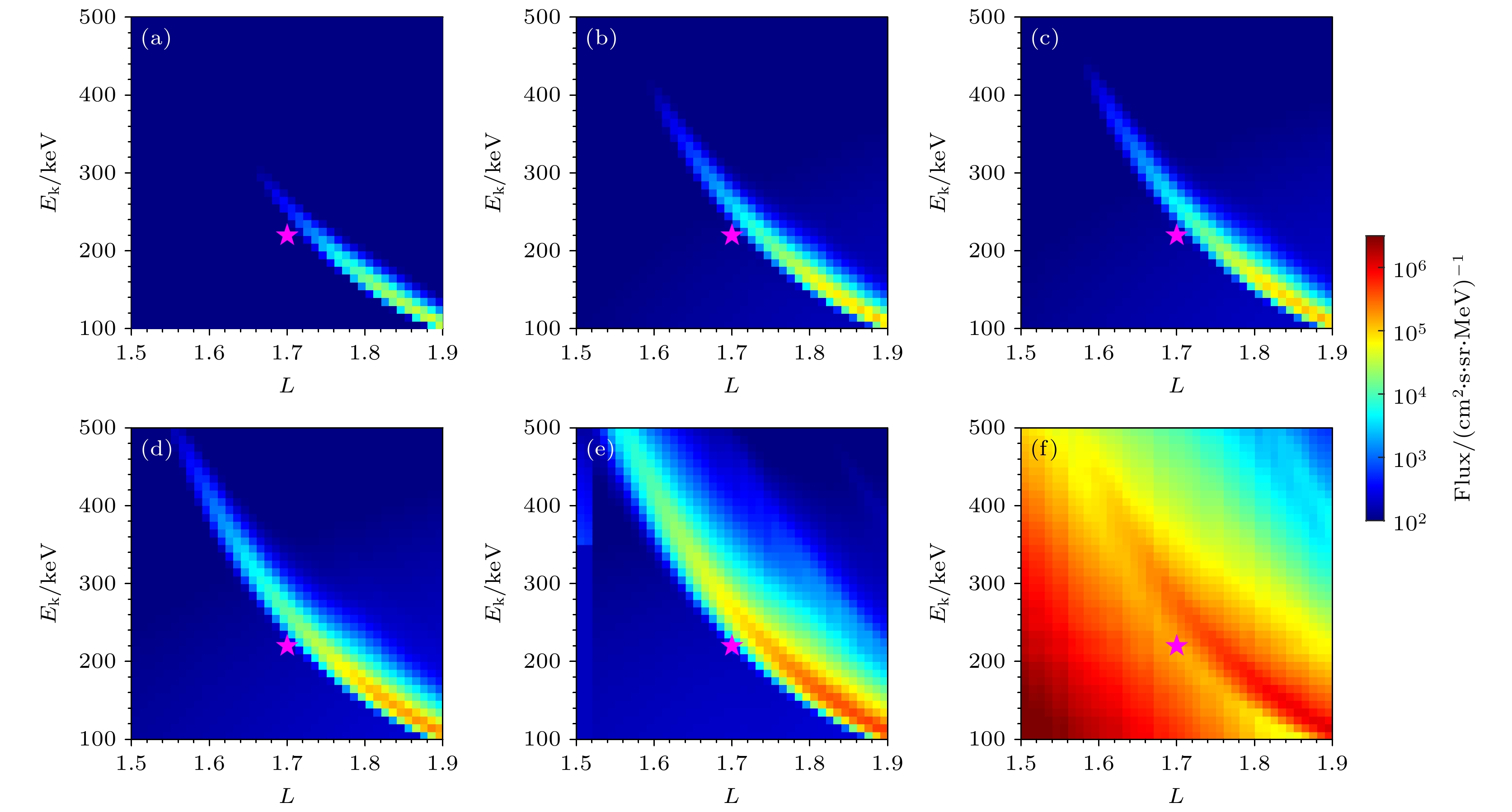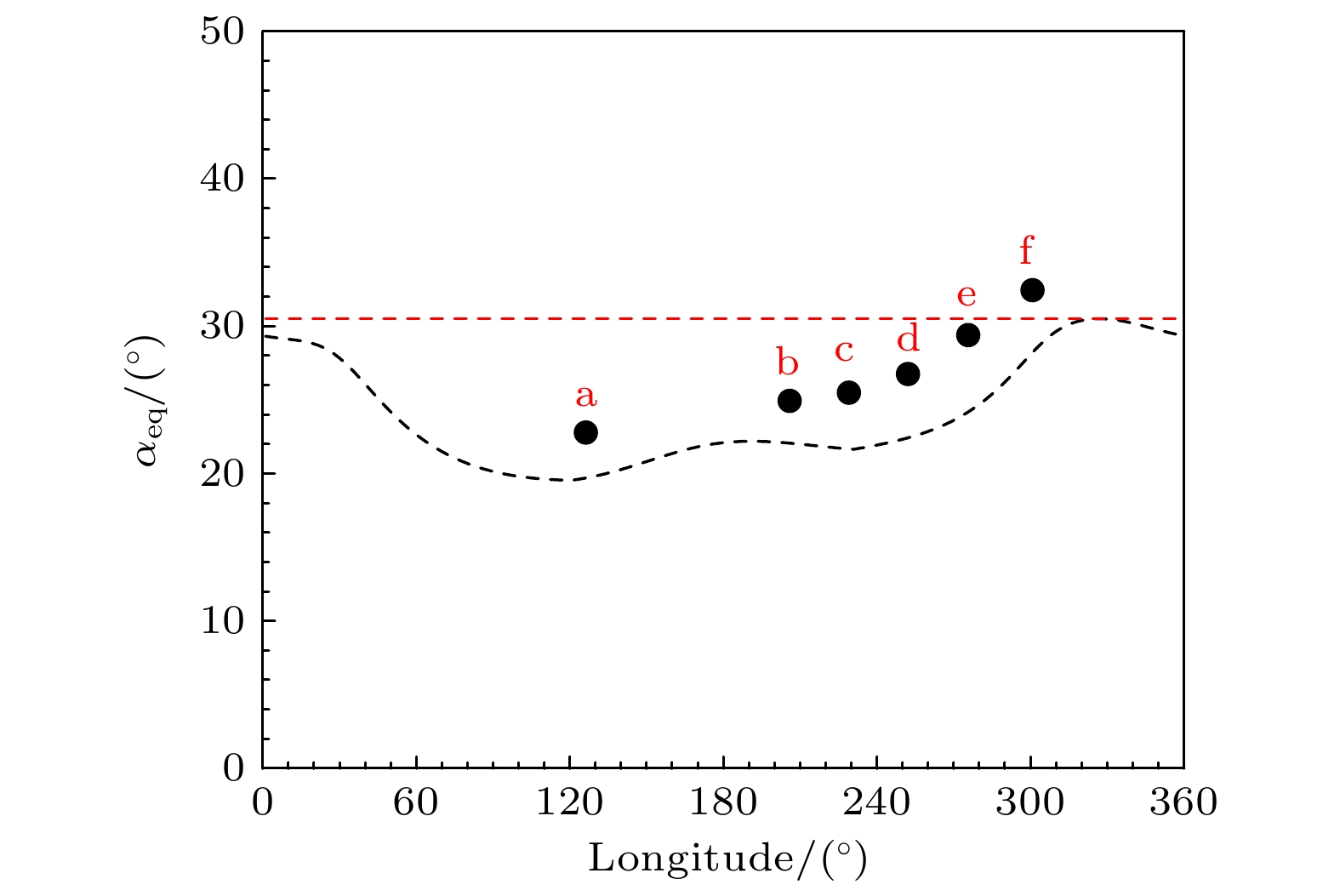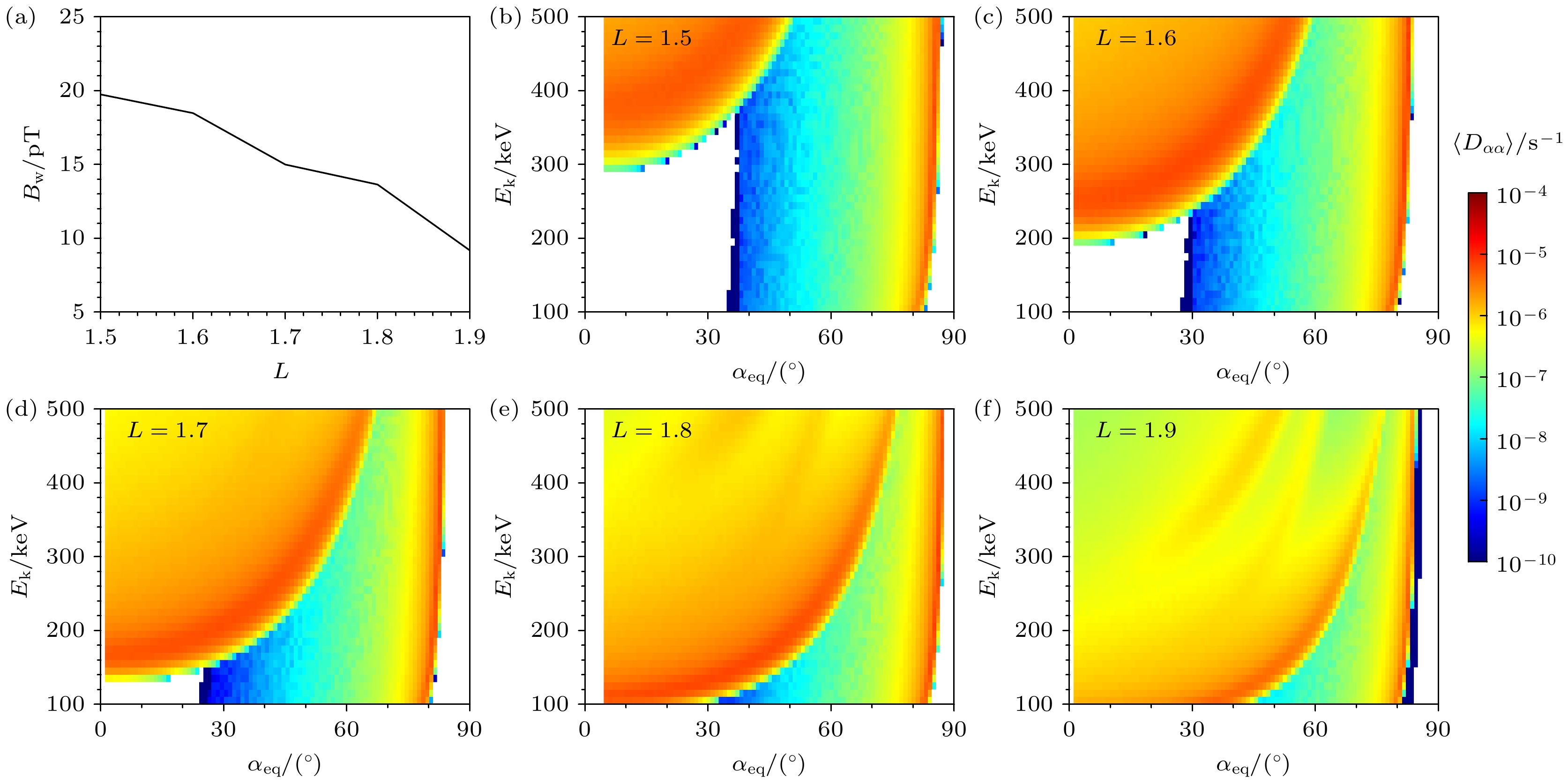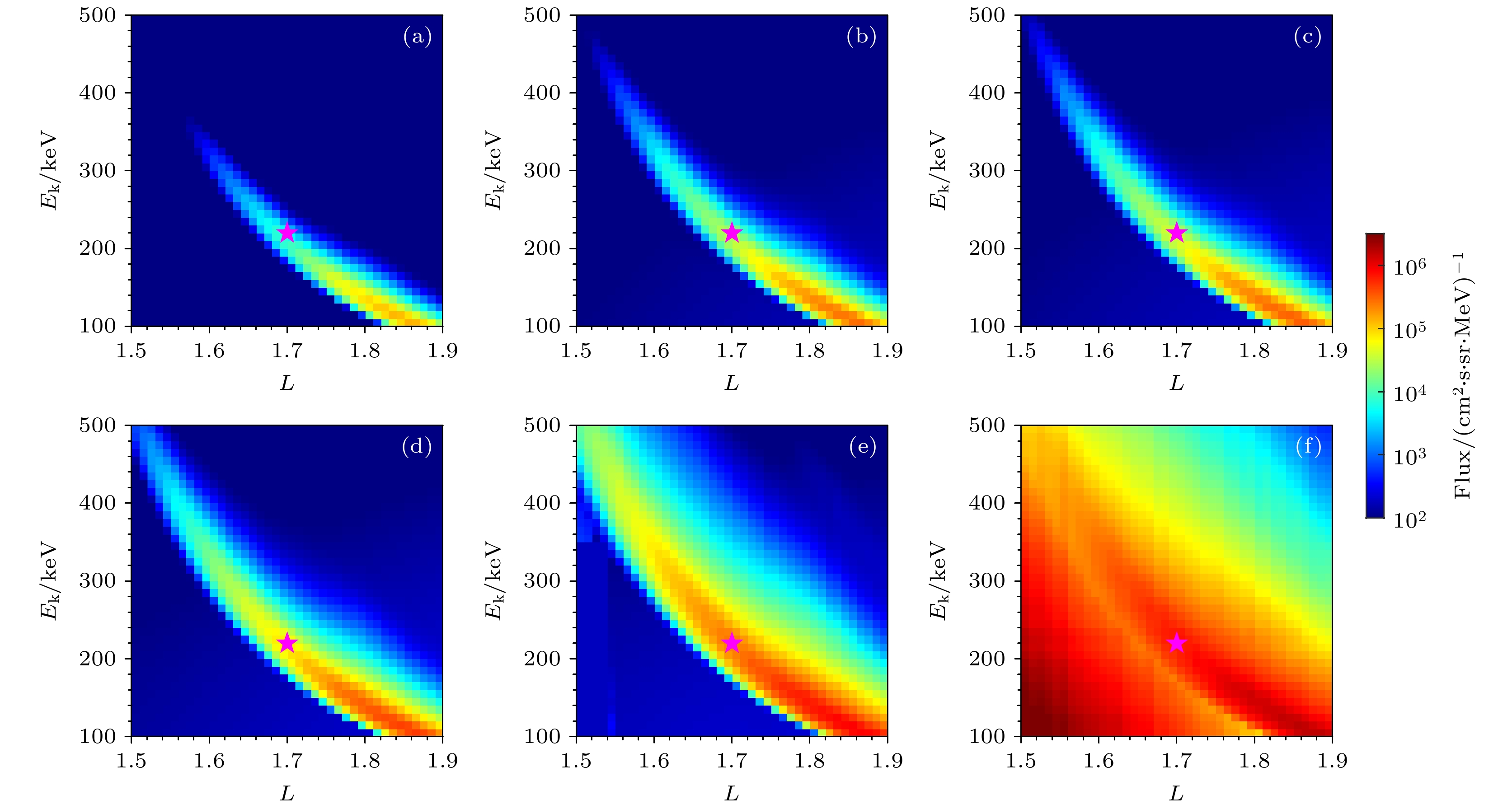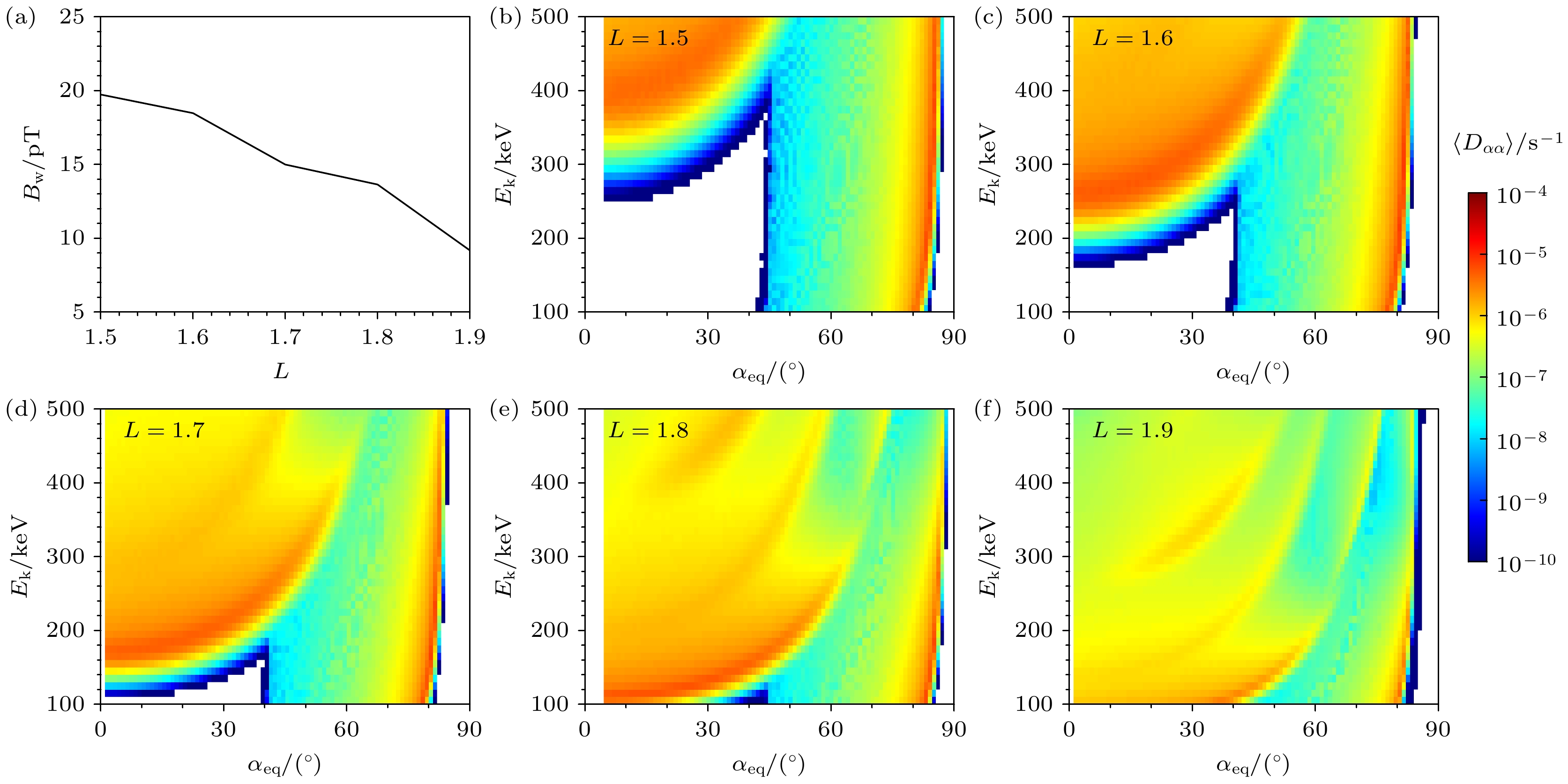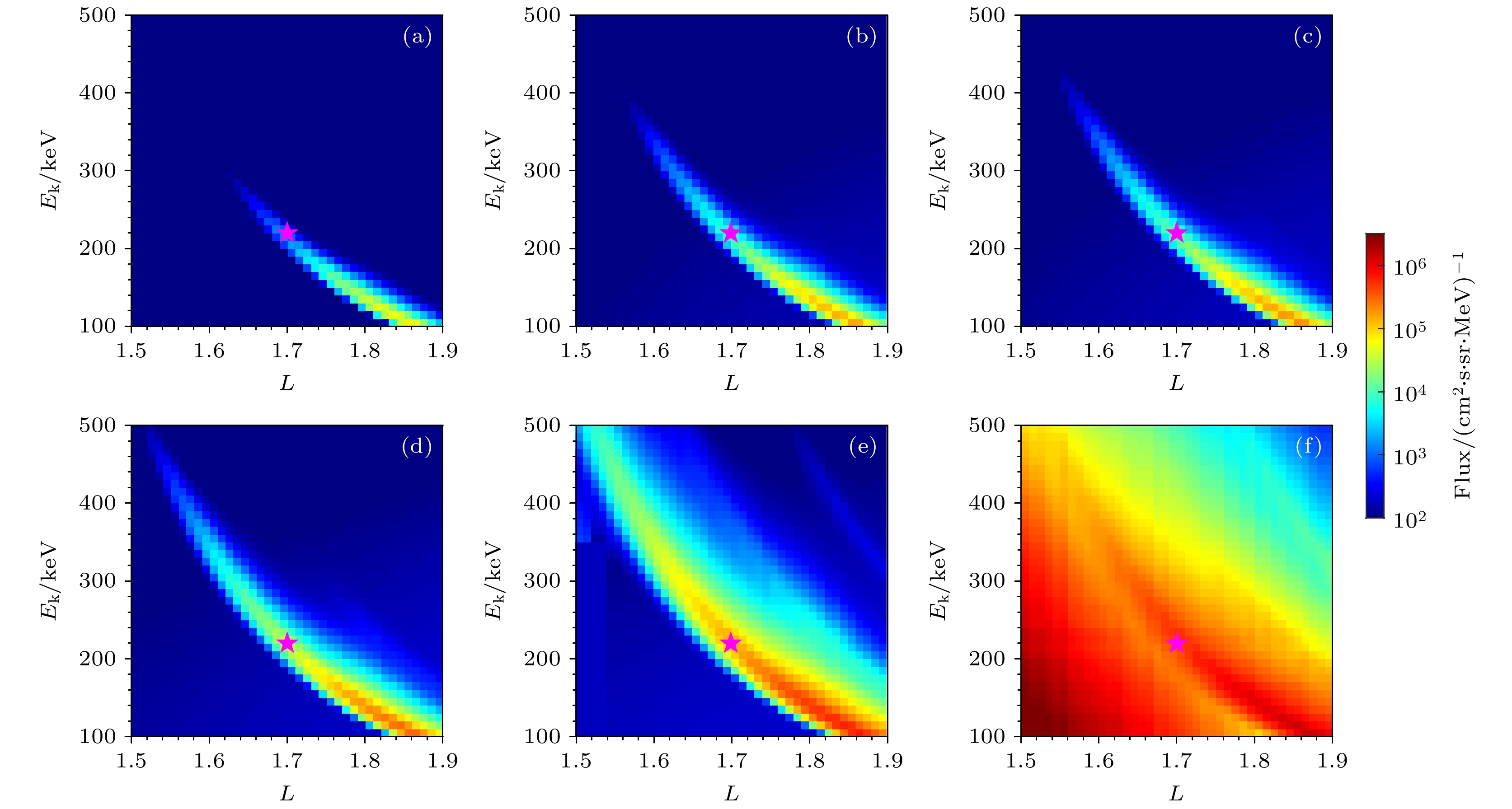-
遍布全球的人工甚低频台站发射的信号主要用于对潜通信, 在夜间, 这些信号可以泄漏进磁层与内辐射带中几十至几百keV电子发生回旋共振, 从而导致电子沉降. 这一过程是导致内辐射带电子损失的重要原因, 也是磁层-电离层耦合过程中能量和物质输运的重要环节. 被台站信号散射的电子呈现出能量随L增加而减小的“条缕状”能谱结构, 与台站信号和电子的一阶回旋共振能量曲线相符. 低轨卫星可以对“条缕状”能谱结构进行清晰地观测, 为研究近地空间波粒相互作用提供了重要契机. 本文基于Drift-Diffusion-Source模型, 复现了DEMETER卫星于2009年3月19日多个轨道测量的NWC台站信号导致的“条缕状”能谱, 量化了NWC台站信号对辐射带电子的散射作用, 明晰了NWC台站信号的幅度和传播角, 揭示了内辐射带电子漂移过程中的动态变化规律, 为开发人工影响辐射带技术提供了重要理论参考.Very low frequency (VLF) signals emitted by worldwide spread ground-based man-made transmitters mainly propagate in Earth-ionospheric waveguides and are used for submarine communication. A portion of these signals penetrate the ionosphere and leak into the magnetosphere when the ionospheric electron density decreases on the nightside due to the attenuated sunlight. The VLF transmitter signals in the magnetosphere can scatter electrons with energy of several hundred keV in the inner radiation belt into the drift loss cone through cyclotron resonance. This is an important loss mechanism for electrons in the inner radiation belt and plays an important role in transferring energy and mass from magnetosphere to ionosphere. Electrons scattered by transmitter signals exhibit a “wisp” characteristic in L-Ek spectrum, satisfying the first-order cyclotron resonance relationship between the electrons and the transmitter signals. The “wisp” spectrum can be clearly observed by low earth orbit satellites, presenting opportunities to study wave-particle interactions in near-Earth space. In this study, using the Drift-Diffusion-Source model, we reproduce the “wisp” spectrum formed by scattering effects of NWC transmitter signals observed by DEMETER satellite on March 19, 2009. Our simulation results suggest that the equatorial pitch angle of electrons, observed by DEMETER, varies with the longitude, resulting in distinctions in the observed “wisp” spectrum along different longitudes. Specifically, as the satellite approaches South Atlantic Anomaly (SAA) region, both the energy range and flux level of the observed “wisp” spectrum gradually increase. When the previously studied wave normal angle model (with a central wave normal angle of 60°) and the background electron density model are used, the energy range of the simulated “wisp” spectra is higher than the observed value. Adjusting the central wave normal angle to 40° or increasing the background density by a factor of 1.3, the simulated results accord well with the observations. Our results elucidate the scattering effect of NWC transmitter signals on electrons in the radiation belt, and emphasize the importance of analyzing the formation of “wisp” spectrum for understanding wave-particle interactions in near-earth space. Additionally, the Drift-Diffusion-Source model can be used to study wave-particle interactions in the inner radiation belt, helping to develop radiation belt remediation technology.
-
Keywords:
- Earth’s radiation belts /
- wave-particle interactions /
- artificial very low frequency transmitter signals /
- electron pitch angle diffusion
[1] Baker D N, Kanekal S G, Hoxie V C, Henderson M G, Li X, Spence H E, Elkington S R, Friedel R H W, Goldstein J, Hudson M K, Reeves G D, Thorne R M, Kletzing C A, Claudepierre S G 2013 Science 340 186
 Google Scholar
Google Scholar
[2] Dong J, Xiang Z, Ni B, Liu Y 2023 J. Geophys. Res. Space Phys. 128 e2023JA031869
 Google Scholar
Google Scholar
[3] Guo D, Xiang Z, Ni B, Cao X, Fu S, Zhou R, Gu X, Yi J, Guo Y, Jiao L 2021 Geophys. Res. Lett. 48 e2021GL095714
 Google Scholar
Google Scholar
[4] Guo D, Xiang Z, Ni B, Jin T, Zhou R, Yi J, Liu Y, Dong J 2023 J. Geophys. Res. Space Phys. 128 e2023JA031407
 Google Scholar
Google Scholar
[5] Tang C L, Xie X J, Ni B, Su Z P, Reeves G D, Zhang J C, Baker D N, Spence H E, Funsten H O, Blake J B, Wygant J R, Dai G Y 2018 J. Geophys. Res. Space Phys. 123 4895
 Google Scholar
Google Scholar
[6] Yang X, Ni B, Yu J, Zhang Y, Zhang X, Sun Y 2017 J. Geophys. Res. Space Phys. 122 6255
 Google Scholar
Google Scholar
[7] Zhu Q, Cao X, Gu X, Ni B, Xiang Z, Fu S, Summers D, Hua M, Lou Y, Ma X, Guo Y, Guo D, Zhang W 2021 J. Geophys. Res. Space Phys. 126 e2020JA029057
 Google Scholar
Google Scholar
[8] 曹兴, 陆鹏, 朱琪, 马新, 倪彬彬 2023 地球物理学报 66 1796
 Google Scholar
Google Scholar
Cao X, Lu P, Zhu Q, Ma X, Ni B B 2023 Chin. J. Geophys. 66 1796
 Google Scholar
Google Scholar
[9] Carlsten B E, Colestock P L, Cunningham G S, Delzanno G L, Dors E E, Holloway M A, Jeffery C A, Lewellen J W, Marksteiner Q R, Nguyen D C, Reeves G D, Shipman K A 2019 IEEE Trans. Plasma Sci. 47 2045
 Google Scholar
Google Scholar
[10] Golkowski M, Harid V, Hosseini P 2019 Front. Astron. Space Sci. 6 2
 Google Scholar
Google Scholar
[11] Johnston W R, Ginet G P, Starks M J, McCollough J P, Sanchez J C, Song P, Galkin I A, Inan U S, Lauben D S, Tu J, Reinisch B W, Linscott I R, Roche K, Stelmash S, Allgeier S, Lambour R, Schoenberg J, Gillespie W, Farrell W M, Xapsos M A, Roddy P A, Lindstrom C D, Pedinotti G F, Huston S L, Albert J M, Sinclair A J, Davis L D, Carilli J A, Cooke D L, Parker C W 2023 J. Geophys. Res. Space Phys. 128 e2022JA030771
 Google Scholar
Google Scholar
[12] Claudepierre S G, Ma Q, Bortnik J, O'Brien T P, Fennell J F, Blake J B 2020 Geophys. Res. Lett. 47 e2019GL086056
 Google Scholar
Google Scholar
[13] Hua M, Li W, Ni B, Ma, Q., Green, A., Shen, X., Claudepierre S G, Bortnik J, Gu X, Fu S, Xiang Z, Reeves G D 2020 Nat. Commun. 11 4847
 Google Scholar
Google Scholar
[14] Hua M, Bortnik J, Ma Q, Bernhardt P A 2022 Geophys. Res. Lett. 49 e2022GL099258
 Google Scholar
Google Scholar
[15] Ni B, Hua M, Gu X, Fu S, Xiang Z, Cao X, Ma X 2022 Sci. China, Ser. D Earth Sci. 65 391
 Google Scholar
Google Scholar
[16] Ni B, Summers D, Xiang Z, Dou, X, Tsurutani B T, Meredith N P, Dong J, Chen L, Reeves G D, Liu X, Tao X, Gu X, Ma X, Yi J, Fu S, Xu W 2023 J. Geophys. Res. Space Physics 128 e2023JA031325
 Google Scholar
Google Scholar
[17] Abel B, Thorne R M 1998 J. Geophys. Res. 103 2385
 Google Scholar
Google Scholar
[18] Albert J M, Starks M J, Selesnick R S, Ling A G, O'Malley S, Quinn R A 2020 J. Geophys. Res. Space Phys. 125 e2019JA027030
 Google Scholar
Google Scholar
[19] Graf K L, Inan U S, Piddyachiy D, Kulkarni P, Parrot M, Sauvaud J A 2009 J. Geophys. Res. Space Phys. 114 A07205
[20] Imhof W L, Reagan J B, Voss H D, Gaines E E, Datlowe D W, Mobilia J, Helliwell R A, Inan U S, Katsufrakis J, Joiner R G 1983 Geophys. Res. Lett. 10 361
 Google Scholar
Google Scholar
[21] Koons H C, Edgar B C, Vampola A L 1981 J. Geophys. Res. Space Phys. 86 640
 Google Scholar
Google Scholar
[22] Li L Y, Wang Z Y, Yu J, Cao J B 2021 J. Geophys. Res. Space Phys. 126 e2020JA028879
 Google Scholar
Google Scholar
[23] Clilverd M A, Rodger C J, Gamble R, Meredith N P, Parrot M, Berthelier J J, Thomson N R 2008 J. Geophys. Res. Space Phys. 113 A04211
[24] 王亚璐, 项正, 泽仁志玛, 倪彬彬, 刘阳希子, 张学民, 欧阳新艳, 吴迎燕, 申旭辉 2023 地球物理学报 66 4451
 Google Scholar
Google Scholar
Wang Y L, Xiang Z, Zeren Z M, Ni B B, Liu Y X Z, Zhang X M, Ouyang X Y, Wu Y Y, Shen X H 2023 Chin. J. Geophys. 66 4451
 Google Scholar
Google Scholar
[25] Ma Q, Mourenas D, Li W, Artemyev A, Thorne R M 2017 Geophys. Res. Lett. 44 6483
 Google Scholar
Google Scholar
[26] Ma Q, Gu W, Claudepierre S G, Li W, Bortnik J, Hua M, Shen X C 2022 J. Geophys. Res. Space Phys. 127 e2022JA030349
 Google Scholar
Google Scholar
[27] Meredith N P, Horne R B, Clilverd M A, Ross J P J 2019 J. Geophys. Res. Space Phys. 124 5246
 Google Scholar
Google Scholar
[28] Ross J P J, Meredith N P, Glauert S A, Horne R B, Clilverd M A 2019 J. Geophys. Res. Space Phys. 124 5260
 Google Scholar
Google Scholar
[29] Wang Y L, Zhang X M, Shen X H 2018 Earth Planet. Phys. 2 538
 Google Scholar
Google Scholar
[30] 项正, 林显浩, 陈薇, 王勇, 陆鹏, 龚文颖, 马文琛, 花漫, 刘阳希子 2021 地球物理学报 64 3860
 Google Scholar
Google Scholar
Xiang Z, Lin X H, Chen W, Wang Y, Lu P, Gong W Y, Ma W C, Hua M, Liu Y X Z 2021 Chin. J. Geophys. 64 3860
 Google Scholar
Google Scholar
[31] Sauvaud J-A, Maggiolo R, Jacquey C, Parrot M, Berthelier J-J, Gamble R J, Rodger C J 2008 Geophys. Res. Lett. 35 L09101
[32] Gamble R J, Rodger C J, Clilverd M A, Sauvaud J-A, Thomson N R, Stewart S L, McCormick R J, Parrot M, Berthelier J-J 2008 J. Geophys. Res. Space Phys. 113 A10211
[33] Li X, Ma Y, Wang P, Wang H, Lu H, Zhang X, Huang J, Shi F, Yu X, Xu Y, Meng X, Wang H, Zhao X, Parrot M 2012 J. Geophys. Res. Space Phys. 117 A04201
[34] Vampola A L, Kuck G A 1978 J. Geophys. Res. Space Phys. 83 2543
 Google Scholar
Google Scholar
[35] Selesnick R S, Albert J M, Starks M J 2013 J. Geophys. Res. Space Phys. 118 628
 Google Scholar
Google Scholar
[36] Liu Y, Xiang Z, Ni B, Li X, Zhang K, Fu S, Gu X, Liu J, Cao X 2022 Geophys. Res. Lett. 49 e2021GL097443
 Google Scholar
Google Scholar
[37] Parrot M 2006 Planet. Space Sci. 54 411
 Google Scholar
Google Scholar
[38] Sauvaud J A, Moreau T, Maggiolo R, Treilhou J P, Jacquey C, Cros A, Coutelier J, Rouzaud J, Penou E, Gangloff M 2006 Planet. Space Sci. 54 502
 Google Scholar
Google Scholar
[39] Li X, Schiller Q, Blum L, Califf S, Zhao H, Tu W, Turner D L, Gerhardt D, Palo S, Kanekal S, Baker D N, Fennell J, Blake J B, Looper M, Reeves G D, Spence H 2013 J. Geophys. Res. Space Phys. 118 6489
 Google Scholar
Google Scholar
[40] Tu W, Selesnick R, Li X, Looper M 2010 J. Geophys. Res. Space Phys. 115 A07210
[41] Hu J, Xiang Z, Ma X, Liu Y, Dong J, Guo D, Ni B 2024 Space Weather 22 e2023SW003827
 Google Scholar
Google Scholar
[42] Zhang K, Li X, Xiang Z, Khoo L Y, Zhao H, Looper M D, Schiller Q, Temerin M A, Sauvaud J A 2020 J. Geophys. Res. Space Phys. 125 e2020JA028086
 Google Scholar
Google Scholar
[43] 胡立凡, 项正, 顾旭东, 倪彬彬, 张效信, 郭建广, 张贤国, 朱昌波, 郭德宇, 付松, 刘阳希子, 董俊虎, 赵怡雯 2023 地球物理学报 66 2252
 Google Scholar
Google Scholar
Hu L F, Xiang Z, Gu X D, Ni B B, Zhang X X, Guo J G, Zhang X G, Zhu C B, Guo D Y, Fu S, Liu Y X Z, Dong J H, Zhao Y W 2023 Chin. J. Geophys. 66 2252
 Google Scholar
Google Scholar
[44] Ozhogin P, Tu J, Song P, Reinisch B W 2012 J. Geophys. Res. Space Phys. 117 A06225
[45] Ni B, Thorne R M, Shprits Y Y, Bortnik J 2008 Geophys. Res. Lett. 35 L11106
[46] Ni B, Thorne R M, Meredith N P, Shprits Y Y, Horne R B 2011 J. Geophys. Res. Space Phys. 116 A10207
[47] Zhang Z, Chen L, Li X, Xia Z, Heelis R A, Horne R B 2018 J. Geophys. Res. Space Phys. 123 5528
 Google Scholar
Google Scholar
[48] Gu W, Chen L, Xia Z, Horne R B 2021 Geophys. Res. Lett. 48 e2021GL093987
 Google Scholar
Google Scholar
[49] Liu Y X Z, Xiang Z, Guo J G, Gu X D, Fu S, Zhou R X, Hua M, Zhu Q, Yi J, Ni B B 2021 Acta Phys. Sin. 70 149401 [刘阳希子, 项正, 郭建广, 顾旭东, 付松, 周若贤, 花漫, 朱琪, 易娟, 倪彬彬 2021 物理学报 70 149401]
 Google Scholar
Google Scholar
Liu Y X Z, Xiang Z, Guo J G, Gu X D, Fu S, Zhou R X, Hua M, Zhu Q, Yi J, Ni B B 2021 Acta Phys. Sin. 70 149401
 Google Scholar
Google Scholar
[50] Xiang Z, Li X, Temerin M A, Ni B, Zhao H, Zhang K, Khoo L Y 2020 a J. Geophys. Res. Space Phys. 125 e2019JA027678
 Google Scholar
Google Scholar
[51] Li X, Selesnick R, Schiller Q, Zhang K, Zhao H, Baker D N, Temerin M A 2017 Nature 552 382
 Google Scholar
Google Scholar
[52] Xiang Z, Li X, Selesnick R, Temerin M A, Ni B, Zhao H, Zhang K, Khoo L Y 2019 Geophys. Res. Lett. 46 1919
 Google Scholar
Google Scholar
[53] Xiang Z, Li X, Ni B, Temerin M A, Zhao H, Zhang K, Khoo L Y 2020 b J. Geophys. Res. Space Phys. 125 e2020JA028042
 Google Scholar
Google Scholar
[54] Selesnick R S 2015 J. Geophys. Res. Space Phys. 120 2912
 Google Scholar
Google Scholar
[55] Selesnick R S 2012 J. Geophys. Res. Space Phys. 117 A08218
[56] Reidy J A, Horne R B, Glauert S A, Clilverd M A, Meredith N P, Rodger C J, Ross J P, Wong J 2024 J. Geophys. Res. Space Phys. 129 e2023JA031641
 Google Scholar
Google Scholar
-
图 1 (I) 2009年3月19日NWC台站位于夜侧时, DEMETER卫星轨道在地理经纬度地图上的投影, 轨道的颜色表示卫星测量电子的类型. 蓝色表示沉降电子, 绿色表示准捕获电子, 红色表示捕获电子. 红色圆点标示出NWC台站的位置, 黑色实线表示L = 1.5和L = 1.9的等值线. 红色字母表示卫星轨道沿经度的分布次序; (a)—(f) (I)中轨道a—f在L = 1.5—1.9处观测到的L-Ek能谱, 颜色表示通量的大小. 能谱中增强的电子通量源自被台站信号散射的捕获电子, 称为“条缕状”能谱. 品红色五角星表示L = 1.7, Ek = 220 keV, 满足电子与传播角为60°的台站信号在赤道处的一阶回旋共振关系
Fig. 1. (I) Trajectories of the DEMETER satellite on geographic map when the NWC station was at the nightside on 19 March 2009. The trajectories are color-coded by the electron type. Blue, red, and green represent untrapped, quasi-trapped, and trapped electrons, respectively. The red dot marks the location of the NWC station, and the solid black lines indicate the contours of L = 1.5 and L = 1.9, respectively. The red letters indicate the order of satellite orbits along longitude; (a)–(f) the electron spectra on L-Ek plane observed by DEMETER in orbits a – f shown in (I), respectively. The enhanced electron fluxes in the spectrum source from trapped electrons scattered by the transmitter signals, which is called “wisp” spectrum. The magenta stars indicate L = 1.7, Ek = 220 keV, satisfying the first-order equatorial cyclotron resonance relationship between the electron and the transmitter signal with wave normal angle of 60°.
图 2 (a) 计算使用的NWC台站信号幅值随L的变化; (b)—(f)中心传播角为60°的台站信号在L = 1.5–1.9引起的电子弹跳平均投掷角扩散系数$\langle D_{\alpha\alpha} \rangle $, 横轴为电子的赤道投掷角αeq, 纵轴为电子能量Ek, 颜色表示$\langle D_{\alpha\alpha} \rangle $的大小
Fig. 2. (a) The amplitudes of the NWC transmitter signals used for calculation; (b)–(f) the color-coded bounce-averaged pitch angle diffusion coefficients $\langle D_{\alpha\alpha} \rangle $ as a function of equatorial pitch angle αeq and electron kinetic energy Ek induced by NWC transmitter signals with 60° central wave normal angle at L = 1.5–1.9, respectively.
图 3 (第一行)模型中采用的电子的弹跳平均投掷角扩散系数$\langle D_{\alpha\alpha} \rangle $, 从左至右分别为L = 1.6处340 keV电子、L = 1.7处220 keV电子、L = 1.8处140 keV电子的$\langle D_{\alpha\alpha} \rangle $, 横坐标表示地磁经度, 纵坐标表示赤道投掷角, 颜色表示扩散系数的大小, 黑色虚线表示使用IGRF磁场模型计算的局地弹跳损失锥大小, VLF台站信号作用经度范围为[99°, 129°]; (第二行)经度114°处, 不同机制导致的扩散系数随投掷角的变化, 黑色虚线表示相应L处的漂移损失锥的大小
Fig. 3. (The first line) The color-coded $\langle D_{\alpha\alpha} \rangle $ as a function of αeq and geomagnetic longitude used in the model, from left to right, is respectively 340 keV at L = 1.6, 220 keV at L = 1.7 and 140 keV at L = 1.8. The black dashed lines represent the local bounce loss cone calculated based on IGRF model, and the longitude range of VLF transmitter signal is [99°, 129°]. (The second line) $\langle D_{\alpha\alpha} \rangle $ as a function of αeq at longitude = 114°. The black dash lines represent the drift loss cone at the corresponding L.
图 4 (从上至下)每一行分别为模型模拟L = 1.6处340 keV, L = 1.7处220 keV, L = 1.8处140 keV电子漂移过程中, 通量随经度和赤道投掷角的分布, 颜色表示电子通量的大小. (从左至右)每一列分别为模型模拟步长为0, 120, 360时的结果, 1步长表示电子漂移经度1°所需的时间, L = 1.6处340 keV电子漂移经度1°约为16.8 s, L = 1.7处220 keV电子漂移经度1°约为23 s, L = 1.8处140 keV电子漂移经度1°约为32.5 s
Fig. 4. (From top to bottom) Each row is the color-coded simulated electron fluxes as function of longitude and αeq during the drift process. (From left to right) Each column represents simulated time step is 0, 120 and 360 respectively. 1 step represents the time required for electron drift 1° longitude. 1 step for 340 keV electron at L = 1.6 is about 16.8 s, for 220 keV electron at L = 1.7 is about 23 s, and for 140 keV electron at L = 1.8 is about 32.5 s.
图 5 假设台站信号中心传播角为60°时, 模拟得到的L-Ek能谱, 颜色表示电子通量的大小, 与图1(a)—(f)的卫星观测能谱一一对应
Fig. 5. Simulated L-Ek spectra assuming the central wave normal angle of the NWC transmitter signal is 60°, which correspond one to one with Figure 1(a)-(f).
图 6 卫星不同轨道在L = 1.7处观测的电子赤道投掷角, 黑色虚线表示使用IGRF磁场模型计算的局地弹跳损失锥大小, 红色虚线表示漂移损失锥大小
Fig. 6. The αeq of electrons observed in different orbits of the satellite at L = 1.7, the black dashed line represents the local bounce loss cone calculated using the IGRF magnetic field model, and the red dashed line represents the drift loss cone.
图 7 (a) 计算使用的NWC台站信号幅值; (b)—(f)中心传播角为40°的台站信号在L = 1.5–1.9引起的电子弹跳平均投掷角扩散系数$\langle D_{\alpha\alpha} \rangle $, 横轴为电子的赤道投掷角αeq, 纵轴为电子能量Ek, 颜色表示$\langle D_{\alpha\alpha} \rangle $的大小
Fig. 7. (a) The amplitude of the NWC transmitter signals used for calculation; (b)–(f) the color-coded bounce-averaged pitch angle diffusion coefficients $\langle D_{\alpha\alpha} \rangle $; as a function of equatorial pitch angle αeq and electron kinetic energy Ek induced by NWC transmitter signals with 40° central wave normal angle at L = 1.5–1.9, respectively.
图 9 (a) 计算使用的NWC台站信号幅值; (b)—(f)背景密度扩大1.3倍之后, 中心传播角为60°的台站信号在L = 1.5—1.9引起的电子弹跳平均投掷角扩散系数$\langle D_{\alpha\alpha} \rangle $, 横轴为电子的赤道投掷角αeq, 纵轴为电子能量Ek, 颜色表示$\langle D_{\alpha\alpha} \rangle $的大小
Fig. 9. (a) The amplitude of the NWC transmitter signals used for calculation; (b)–(f) the color-coded bounce-averaged pitch angle diffusion coefficients $\langle D_{\alpha\alpha} \rangle $ as a function of equatorial pitch angle αeq and electron kinetic energy Ek induced by NWC transmitter signals with 60° central wave normal angle at L = 1.5–1.9, respectively, when the background density is enlarged by a factor of 1.3
-
[1] Baker D N, Kanekal S G, Hoxie V C, Henderson M G, Li X, Spence H E, Elkington S R, Friedel R H W, Goldstein J, Hudson M K, Reeves G D, Thorne R M, Kletzing C A, Claudepierre S G 2013 Science 340 186
 Google Scholar
Google Scholar
[2] Dong J, Xiang Z, Ni B, Liu Y 2023 J. Geophys. Res. Space Phys. 128 e2023JA031869
 Google Scholar
Google Scholar
[3] Guo D, Xiang Z, Ni B, Cao X, Fu S, Zhou R, Gu X, Yi J, Guo Y, Jiao L 2021 Geophys. Res. Lett. 48 e2021GL095714
 Google Scholar
Google Scholar
[4] Guo D, Xiang Z, Ni B, Jin T, Zhou R, Yi J, Liu Y, Dong J 2023 J. Geophys. Res. Space Phys. 128 e2023JA031407
 Google Scholar
Google Scholar
[5] Tang C L, Xie X J, Ni B, Su Z P, Reeves G D, Zhang J C, Baker D N, Spence H E, Funsten H O, Blake J B, Wygant J R, Dai G Y 2018 J. Geophys. Res. Space Phys. 123 4895
 Google Scholar
Google Scholar
[6] Yang X, Ni B, Yu J, Zhang Y, Zhang X, Sun Y 2017 J. Geophys. Res. Space Phys. 122 6255
 Google Scholar
Google Scholar
[7] Zhu Q, Cao X, Gu X, Ni B, Xiang Z, Fu S, Summers D, Hua M, Lou Y, Ma X, Guo Y, Guo D, Zhang W 2021 J. Geophys. Res. Space Phys. 126 e2020JA029057
 Google Scholar
Google Scholar
[8] 曹兴, 陆鹏, 朱琪, 马新, 倪彬彬 2023 地球物理学报 66 1796
 Google Scholar
Google Scholar
Cao X, Lu P, Zhu Q, Ma X, Ni B B 2023 Chin. J. Geophys. 66 1796
 Google Scholar
Google Scholar
[9] Carlsten B E, Colestock P L, Cunningham G S, Delzanno G L, Dors E E, Holloway M A, Jeffery C A, Lewellen J W, Marksteiner Q R, Nguyen D C, Reeves G D, Shipman K A 2019 IEEE Trans. Plasma Sci. 47 2045
 Google Scholar
Google Scholar
[10] Golkowski M, Harid V, Hosseini P 2019 Front. Astron. Space Sci. 6 2
 Google Scholar
Google Scholar
[11] Johnston W R, Ginet G P, Starks M J, McCollough J P, Sanchez J C, Song P, Galkin I A, Inan U S, Lauben D S, Tu J, Reinisch B W, Linscott I R, Roche K, Stelmash S, Allgeier S, Lambour R, Schoenberg J, Gillespie W, Farrell W M, Xapsos M A, Roddy P A, Lindstrom C D, Pedinotti G F, Huston S L, Albert J M, Sinclair A J, Davis L D, Carilli J A, Cooke D L, Parker C W 2023 J. Geophys. Res. Space Phys. 128 e2022JA030771
 Google Scholar
Google Scholar
[12] Claudepierre S G, Ma Q, Bortnik J, O'Brien T P, Fennell J F, Blake J B 2020 Geophys. Res. Lett. 47 e2019GL086056
 Google Scholar
Google Scholar
[13] Hua M, Li W, Ni B, Ma, Q., Green, A., Shen, X., Claudepierre S G, Bortnik J, Gu X, Fu S, Xiang Z, Reeves G D 2020 Nat. Commun. 11 4847
 Google Scholar
Google Scholar
[14] Hua M, Bortnik J, Ma Q, Bernhardt P A 2022 Geophys. Res. Lett. 49 e2022GL099258
 Google Scholar
Google Scholar
[15] Ni B, Hua M, Gu X, Fu S, Xiang Z, Cao X, Ma X 2022 Sci. China, Ser. D Earth Sci. 65 391
 Google Scholar
Google Scholar
[16] Ni B, Summers D, Xiang Z, Dou, X, Tsurutani B T, Meredith N P, Dong J, Chen L, Reeves G D, Liu X, Tao X, Gu X, Ma X, Yi J, Fu S, Xu W 2023 J. Geophys. Res. Space Physics 128 e2023JA031325
 Google Scholar
Google Scholar
[17] Abel B, Thorne R M 1998 J. Geophys. Res. 103 2385
 Google Scholar
Google Scholar
[18] Albert J M, Starks M J, Selesnick R S, Ling A G, O'Malley S, Quinn R A 2020 J. Geophys. Res. Space Phys. 125 e2019JA027030
 Google Scholar
Google Scholar
[19] Graf K L, Inan U S, Piddyachiy D, Kulkarni P, Parrot M, Sauvaud J A 2009 J. Geophys. Res. Space Phys. 114 A07205
[20] Imhof W L, Reagan J B, Voss H D, Gaines E E, Datlowe D W, Mobilia J, Helliwell R A, Inan U S, Katsufrakis J, Joiner R G 1983 Geophys. Res. Lett. 10 361
 Google Scholar
Google Scholar
[21] Koons H C, Edgar B C, Vampola A L 1981 J. Geophys. Res. Space Phys. 86 640
 Google Scholar
Google Scholar
[22] Li L Y, Wang Z Y, Yu J, Cao J B 2021 J. Geophys. Res. Space Phys. 126 e2020JA028879
 Google Scholar
Google Scholar
[23] Clilverd M A, Rodger C J, Gamble R, Meredith N P, Parrot M, Berthelier J J, Thomson N R 2008 J. Geophys. Res. Space Phys. 113 A04211
[24] 王亚璐, 项正, 泽仁志玛, 倪彬彬, 刘阳希子, 张学民, 欧阳新艳, 吴迎燕, 申旭辉 2023 地球物理学报 66 4451
 Google Scholar
Google Scholar
Wang Y L, Xiang Z, Zeren Z M, Ni B B, Liu Y X Z, Zhang X M, Ouyang X Y, Wu Y Y, Shen X H 2023 Chin. J. Geophys. 66 4451
 Google Scholar
Google Scholar
[25] Ma Q, Mourenas D, Li W, Artemyev A, Thorne R M 2017 Geophys. Res. Lett. 44 6483
 Google Scholar
Google Scholar
[26] Ma Q, Gu W, Claudepierre S G, Li W, Bortnik J, Hua M, Shen X C 2022 J. Geophys. Res. Space Phys. 127 e2022JA030349
 Google Scholar
Google Scholar
[27] Meredith N P, Horne R B, Clilverd M A, Ross J P J 2019 J. Geophys. Res. Space Phys. 124 5246
 Google Scholar
Google Scholar
[28] Ross J P J, Meredith N P, Glauert S A, Horne R B, Clilverd M A 2019 J. Geophys. Res. Space Phys. 124 5260
 Google Scholar
Google Scholar
[29] Wang Y L, Zhang X M, Shen X H 2018 Earth Planet. Phys. 2 538
 Google Scholar
Google Scholar
[30] 项正, 林显浩, 陈薇, 王勇, 陆鹏, 龚文颖, 马文琛, 花漫, 刘阳希子 2021 地球物理学报 64 3860
 Google Scholar
Google Scholar
Xiang Z, Lin X H, Chen W, Wang Y, Lu P, Gong W Y, Ma W C, Hua M, Liu Y X Z 2021 Chin. J. Geophys. 64 3860
 Google Scholar
Google Scholar
[31] Sauvaud J-A, Maggiolo R, Jacquey C, Parrot M, Berthelier J-J, Gamble R J, Rodger C J 2008 Geophys. Res. Lett. 35 L09101
[32] Gamble R J, Rodger C J, Clilverd M A, Sauvaud J-A, Thomson N R, Stewart S L, McCormick R J, Parrot M, Berthelier J-J 2008 J. Geophys. Res. Space Phys. 113 A10211
[33] Li X, Ma Y, Wang P, Wang H, Lu H, Zhang X, Huang J, Shi F, Yu X, Xu Y, Meng X, Wang H, Zhao X, Parrot M 2012 J. Geophys. Res. Space Phys. 117 A04201
[34] Vampola A L, Kuck G A 1978 J. Geophys. Res. Space Phys. 83 2543
 Google Scholar
Google Scholar
[35] Selesnick R S, Albert J M, Starks M J 2013 J. Geophys. Res. Space Phys. 118 628
 Google Scholar
Google Scholar
[36] Liu Y, Xiang Z, Ni B, Li X, Zhang K, Fu S, Gu X, Liu J, Cao X 2022 Geophys. Res. Lett. 49 e2021GL097443
 Google Scholar
Google Scholar
[37] Parrot M 2006 Planet. Space Sci. 54 411
 Google Scholar
Google Scholar
[38] Sauvaud J A, Moreau T, Maggiolo R, Treilhou J P, Jacquey C, Cros A, Coutelier J, Rouzaud J, Penou E, Gangloff M 2006 Planet. Space Sci. 54 502
 Google Scholar
Google Scholar
[39] Li X, Schiller Q, Blum L, Califf S, Zhao H, Tu W, Turner D L, Gerhardt D, Palo S, Kanekal S, Baker D N, Fennell J, Blake J B, Looper M, Reeves G D, Spence H 2013 J. Geophys. Res. Space Phys. 118 6489
 Google Scholar
Google Scholar
[40] Tu W, Selesnick R, Li X, Looper M 2010 J. Geophys. Res. Space Phys. 115 A07210
[41] Hu J, Xiang Z, Ma X, Liu Y, Dong J, Guo D, Ni B 2024 Space Weather 22 e2023SW003827
 Google Scholar
Google Scholar
[42] Zhang K, Li X, Xiang Z, Khoo L Y, Zhao H, Looper M D, Schiller Q, Temerin M A, Sauvaud J A 2020 J. Geophys. Res. Space Phys. 125 e2020JA028086
 Google Scholar
Google Scholar
[43] 胡立凡, 项正, 顾旭东, 倪彬彬, 张效信, 郭建广, 张贤国, 朱昌波, 郭德宇, 付松, 刘阳希子, 董俊虎, 赵怡雯 2023 地球物理学报 66 2252
 Google Scholar
Google Scholar
Hu L F, Xiang Z, Gu X D, Ni B B, Zhang X X, Guo J G, Zhang X G, Zhu C B, Guo D Y, Fu S, Liu Y X Z, Dong J H, Zhao Y W 2023 Chin. J. Geophys. 66 2252
 Google Scholar
Google Scholar
[44] Ozhogin P, Tu J, Song P, Reinisch B W 2012 J. Geophys. Res. Space Phys. 117 A06225
[45] Ni B, Thorne R M, Shprits Y Y, Bortnik J 2008 Geophys. Res. Lett. 35 L11106
[46] Ni B, Thorne R M, Meredith N P, Shprits Y Y, Horne R B 2011 J. Geophys. Res. Space Phys. 116 A10207
[47] Zhang Z, Chen L, Li X, Xia Z, Heelis R A, Horne R B 2018 J. Geophys. Res. Space Phys. 123 5528
 Google Scholar
Google Scholar
[48] Gu W, Chen L, Xia Z, Horne R B 2021 Geophys. Res. Lett. 48 e2021GL093987
 Google Scholar
Google Scholar
[49] Liu Y X Z, Xiang Z, Guo J G, Gu X D, Fu S, Zhou R X, Hua M, Zhu Q, Yi J, Ni B B 2021 Acta Phys. Sin. 70 149401 [刘阳希子, 项正, 郭建广, 顾旭东, 付松, 周若贤, 花漫, 朱琪, 易娟, 倪彬彬 2021 物理学报 70 149401]
 Google Scholar
Google Scholar
Liu Y X Z, Xiang Z, Guo J G, Gu X D, Fu S, Zhou R X, Hua M, Zhu Q, Yi J, Ni B B 2021 Acta Phys. Sin. 70 149401
 Google Scholar
Google Scholar
[50] Xiang Z, Li X, Temerin M A, Ni B, Zhao H, Zhang K, Khoo L Y 2020 a J. Geophys. Res. Space Phys. 125 e2019JA027678
 Google Scholar
Google Scholar
[51] Li X, Selesnick R, Schiller Q, Zhang K, Zhao H, Baker D N, Temerin M A 2017 Nature 552 382
 Google Scholar
Google Scholar
[52] Xiang Z, Li X, Selesnick R, Temerin M A, Ni B, Zhao H, Zhang K, Khoo L Y 2019 Geophys. Res. Lett. 46 1919
 Google Scholar
Google Scholar
[53] Xiang Z, Li X, Ni B, Temerin M A, Zhao H, Zhang K, Khoo L Y 2020 b J. Geophys. Res. Space Phys. 125 e2020JA028042
 Google Scholar
Google Scholar
[54] Selesnick R S 2015 J. Geophys. Res. Space Phys. 120 2912
 Google Scholar
Google Scholar
[55] Selesnick R S 2012 J. Geophys. Res. Space Phys. 117 A08218
[56] Reidy J A, Horne R B, Glauert S A, Clilverd M A, Meredith N P, Rodger C J, Ross J P, Wong J 2024 J. Geophys. Res. Space Phys. 129 e2023JA031641
 Google Scholar
Google Scholar
计量
- 文章访问数: 4098
- PDF下载量: 240
- 被引次数: 0













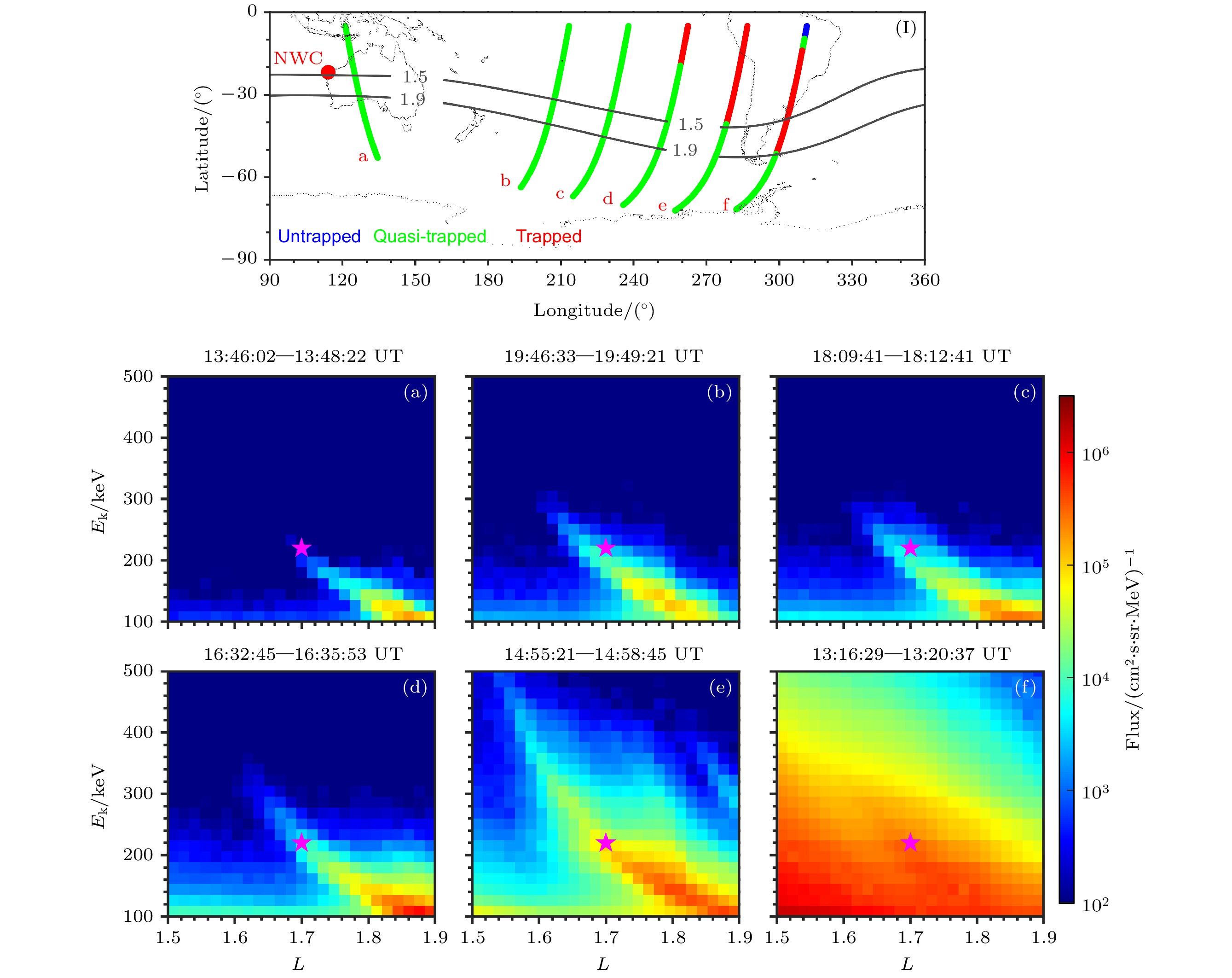
 下载:
下载:
